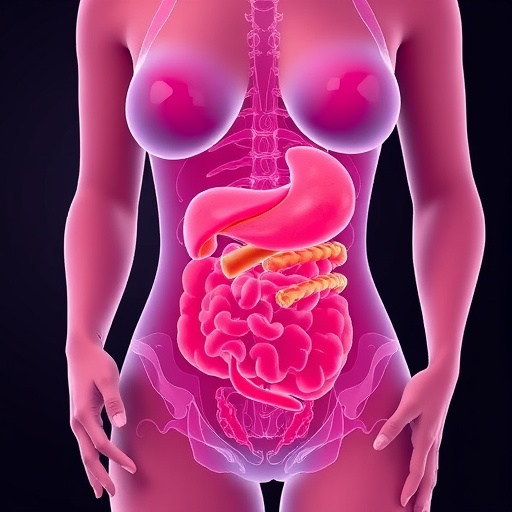Recent research from the Institute of Science Tokyo has unveiled a groundbreaking mechanism that contributes to the remarkable differences in brown adipose tissue (BAT) thermogenic activity between female and male mice. This novel study sheds light on the sex-specific regulation of energy expenditure orchestrated by the transcriptional coactivator PGC-1α (Peroxisome proliferator-activated receptor gamma coactivator 1-alpha), revealing a complex interplay between phospholipid synthesis and mitochondrial function that underpins enhanced heat production in females. These findings not only deepen our understanding of sex-dependent metabolic regulation but also open avenues for developing innovative therapies targeting obesity and diabetes.
Obesity remains a pervasive global health challenge, intimately linked with metabolic disorders such as type 2 diabetes and cardiovascular diseases. Epidemiological data have consistently shown that despite similar or higher rates of obesity, women tend to have a lower incidence of obesity-associated diabetes and cardiovascular complications compared to men. This disparity has long suggested inherent biological differences modulating metabolic health, yet the molecular underpinnings have been obscure. Brown adipose tissue, a highly specialized fat depot responsible for non-shivering thermogenesis and energy dissipation, emerges as a crucial player given its known higher activity levels in females relative to males.
The research team, comprising experts from the Institute of Science Tokyo and the University of Tokyo, leveraged genetically engineered mouse models to dissect the role of PGC-1α specifically in brown fat cells. This protein has been widely recognized as a master regulator of mitochondrial biogenesis and energy metabolism across multiple tissues; however, its sex-specific function in BAT had remained uncharted territory. By selectively deleting the PGC-1α gene in brown fat tissue, the investigators observed a striking phenotype wherein female mice exhibited impaired thermogenesis, diminished oxygen consumption, and altered mitochondrial ultrastructure, while male counterparts showed negligible effects.
Multi-omics approaches—encompassing transcriptomic, metabolomic, and lipidomic analyses—were instrumental in delineating the molecular landscape altered by PGC-1α deficiency. Transcriptomic profiling revealed downregulation of genes implicated in de novo lipogenesis (DNL), particularly those governed by ChREBPβ (Carbohydrate-response element-binding protein beta), a known transcriptional activator of lipogenic pathways. This downregulation bore profound metabolic consequences, as lipidomic analyses demonstrated a significant reduction in critical phospholipid species such as ether-linked phosphatidylethanolamine and cardiolipin. These phospholipids are vital components of the mitochondrial inner membrane, essential for maintaining mitochondrial structural integrity and optimizing electron transport chain function.
The attenuation of phospholipid synthesis triggered cascading mitochondrial dysfunction specifically in female BAT. Electron microscopy disclosed disrupted mitochondrial cristae architecture and reduced cristae density, which correlate with compromised oxidative phosphorylation efficiency. Functionally, this mitochondrial impairment manifested as lower heat production and decreased systemic energy expenditure. The male mice maintained more intact mitochondrial morphology and function, indicating that the PGC-1α-dependent lipid synthesis pathway is critically active and indispensable for female BAT thermogenesis but operates differently or less stringently in males.
Intriguingly, the study further elucidated the hormonal regulation that enhances this pathway in females. Estrogen signaling was shown to amplify the expression of PGC-1α and downstream lipogenic genes, thereby potentiating the lipid synthesis machinery and mitochondrial robustness in female brown fat. This synergy between PGC-1α and estrogen provides a mechanistic basis for the observed superior thermogenic capacity in females, linking sex hormones directly to metabolic programming in BAT.
To corroborate the centrality of ChREBPβ in this cascade, the researchers conducted targeted suppression of ChREBPβ in female mice, which phenocopied the mitochondrial disruptions and reduced thermogenesis seen with PGC-1α deletion. This not only confirms ChREBPβ as a pivotal effector downstream of PGC-1α but also rules out off-target effects, thereby sharpening the mechanistic clarity. The lack of similar effects in males upon ChREBPβ suppression reiterates the sex-specific nature of this regulatory axis.
Taken together, these findings unveil a female-specific metabolic pathway wherein PGC-1α orchestrates phospholipid biosynthesis via ChREBPβ, synergized by estrogen, culminating in fortified mitochondrial architecture and elevated brown fat thermogenic function. This pathway represents an evolutionarily conserved mechanism potentially designed to meet the greater metabolic demands and thermal regulation needs in females, thereby contributing to observed sex differences in metabolic disease susceptibility.
The implications for biomedical science and therapeutic development are profound. By targeting the PGC-1α–ChREBPβ lipid synthesis axis, it may be possible to selectively enhance brown fat activity and mitochondrial function, thereby boosting energy expenditure and ameliorating metabolic diseases such as obesity and diabetes. This sex-specific strategy promises to tailor interventions that respect biological differences, enhancing efficacy and reducing adverse effects.
Furthermore, the elucidation of estrogen’s role in amplifying this metabolic axis underscores the importance of considering hormonal milieu in understanding metabolic health and disease. Future studies may continue to explore the dynamic interplay between sex hormones, transcriptional regulators, and lipid metabolism across diverse tissues and physiological states.
This research not only clarifies a longstanding biological enigma behind sex differences in energy metabolism but also exemplifies the power of integrative multi-omics combined with sophisticated genetic models to uncover intricate physiological pathways. As obesity and metabolic disorders continue to challenge global health, such mechanistic revelations pave the way for precision medicine approaches that harness the body’s own metabolic regulatory systems.
By expanding our molecular understanding of BAT functionality and its regulation by sex-specific factors, this study ignites new scientific inquiries and translational opportunities. The prospect of leveraging brown fat thermogenesis to combat metabolic dysfunction holds immense promise, with PGC-1α-mediated phospholipid synthesis now emerging as a central target illuminated by this pioneering work.
Subject of Research: Animals
Article Title: Sex difference in BAT thermogenesis depends on PGC-1α–mediated phospholipid synthesis in mice
News Publication Date: 14-Jul-2025
Web References:
https://doi.org/10.1038/s41467-025-61219-w
Image Credits: Institute of Science Tokyo
Keywords: Obesity, Metabolic disorders, Diseases and disorders, Health and medicine, Diabetes




